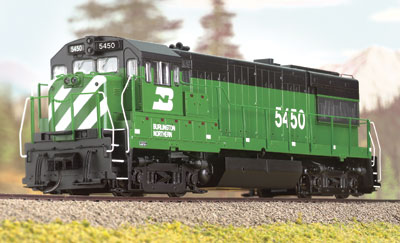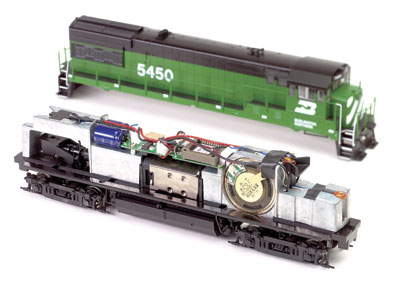One-year wonder. General Electric manufactured the U28B only in 1966, producing 148 units for nine railroads including Chicago, Burling-ton & Quincy (20); Great Northern (6); Louisville & Nashville (5); Milwaukee Road (17); New York Central (2); Norfolk & Western (30); Pittsburgh & Lake Erie (22); Rock Island (42); and Southern Pacific (4). Life-Like’s model is based on the late U28B, which featured a short nose, larger radiator section, and flat walkways below the radiator (the early U28B had a box below the radiator that housed the oil- bath air filters).
Shell details. The model features a cleanly molded plastic body with four primary components: cab, long hood, nose, and walkway/side sill assembly. The hood and nose have tabs that lock into the inside edge of the walkway, while the cab slides into grooves in the hood and nose. The cab also has four tabs that snap into holes on the walkway above the battery and equipment doors.
Life-Like has two different cabs (small- and large-corner-radius cab windows) and noses (with and without headlights) to match specific prototypes. The steps and footboard pilots are see-through, and the walkways have a non-skid texture. The etched-metal see-through air-intake screens add a nice touch.
The factory-installed acetal plastic handrails are also nicely done. The vertical corner grab irons are separate pieces molded in white that are pressed into tiny sockets in the handrail stanchions.
In order to accommodate the two inward-facing speakers and the printed-circuit (PC) board, the five-pole skew-wound motor is seated low in a hollow recess in the middle of the chassis. Two zinc-alloy weights account for much of the model’s 15¾ ounces.
The trucks feature die-cast metal sideframes and plastic gear boxes. The blackened nickel-silver wheels are mounted on stub axles pressed into plastic gear hubs. Brass contact strips are hidden inside the truck sideframes to pick up current from all eight drivers.
A BN Green machine. Our sample came decorated for Burlington Northern. The sample was crisply painted with clean separation lines. Even the fire extinguisher inside and danger 600 volts labels, as well as the GE builder’s plate, were legible. The paint scheme is correct for the period right after the merger that created BN in March 1970.
By the numbers. Life-Like’s model U28B closely matches drawings in the 1966 Simmons-Boardman Car and Locomotive Cyclopedia. On DC our sample ran smoothly at 2.5 scale miles per hour. Its top speed of 111 mph is 25 to 40 mph faster than the prototypes, depending on their gear ratios. On DCC, the starting speed was 4.7 mph, with a top speed of 164 mph.
The U28B has a drawbar pull of 2.72 ounces, which is equivalent to 38 free-rolling freight cars on straight and level track.
On DCC the model started making engine start-up sounds once its default address (3) was entered into the DCC system. Both the speed and intensity of the sounds varied to follow the throttle. The bell has a nice ringing tone, and the horn produces long and short blasts that don’t sound clipped.
While those effects were nice, a big thumbs up goes to the sounds of the diesel engine. The distinctive “lugging” sound made by GE units was clearly audible. Well done!
Life-Like did a terrific job on its HO scale U28B. The model features a lot of nice factory-installed detail, and more can be added by the modeler. With its authentic sounds that can be enjoyed in both DC and DCC, the U28B will be a must-have for GE fans.
Add-on detail parts
Blackened RP-25 metal wheels (correctly gauged)
Constant directional lighting
Die-cast metal chassis and truck sideframes
Drawbar pull: 2.72 ounces
Engine weight: 15.75 ounces
Five-pole, skew-wound motor with dual flywheels
Illuminated number boxes
Magnetic knuckle couplers mounted at correct height
Minimum radius: 18″
Prototype-specific details
QSI Quantum sound and dual-
mode control system with General Electric diesel engine and many other sounds
Overall length, 58′-6″ (8?”)
Two truck types: Association of American Railroads type B, or EMD GP “Blomberg” trucks
















